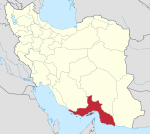Abu Musa
 | |
| Geography | |
|---|---|
| Location | Persian Gulf |
| Coordinates | 25°52′N 55°02′E / 25.867°N 55.033°E |
| Area | 12 km2 (4.6 sq mi) |
| Administration | |
| Demographics | |
| Population | 2,038 |
- This is a geographical article. For the Palestinian leader, see Said al-Muragha, for the Sahaba, see Abu-Musa al-Asha'ari.
Abu Musa (Persian: ابوموسی, Arabic: أبو موسى - Abū Mūsā) is a 12-km² island in the eastern Persian Gulf, part of a six-island archipelago near the entrance to the Strait of Hormuz[1]. The island is administered by Iran as part of the Iranian province of Hormozgan, but is also claimed by the United Arab Emirates (UAE). [2] [3] [4] [5]
Historical ownership of Abu Musa is disputed between Iran and the UAE. The UK administered the island along with the other British-controlled islands in the Persian Gulf, including what is today the UAE. In the late 1960s, Britain transferred administration of the island to the British-appointed Sharjah, one of the seven sheikdoms that would later form the UAE. After Britain announced in 1968 that it would relinquish its hegemony in the Persian Gulf, Iran moved to reattach the island politically to the mainland. In November 1971, UAE and Iran agreed to give sovereignty to the former but allowed the latter to station troops on the island.
In 1980, the UAE took its claim to the United Nations.[2] In same year, Saddam Hussein attempted to justify the Iraq-Iran war by claiming that one of the objectives was to "liberate" Abu Musa, Greater Tunb, and Lesser Tunb. In 1992, Iran increased its control by expelling foreign workers who operated the UAE-sponsored school, medical clinic, and power-generating station.[6]
Abu Musa's roughly 2,000 inhabitants call it "Gap-sabzu" (Persian: گپسبزو), which means "the great green place." On old maps, the island is called Bumuf or Bum-i Musa, Persian for "the land of Musa/Moses."
As of 2010 the island had some 2,038 inhabitants making it Iran's smallest county.[1] The city of Abu Musa had a population of 1,868 as of 2010.[2]
References
- ^ Iranian Islands of Tunbs and Abu Musa
- ^ a b Article about Abu Musa in the Trade & Environment Database of the Mandala Projects (supervised by Prof. Jim Lee), hosted at the American University, Washington, D.C.
- ^ ""Abu Musa and The Tumbs: The Dispute That Won't Go Away, Part Two," July 28, 2001, in The Estimate, vol. XIII, no. 3". Retrieved 2008-01-06.
- ^ ""Iran, its territorial integrity in the Persian gulf region," 20 December 2007". Retrieved 2008-01-06.
- ^ ""Unwanted Guest: The Gulf Summit and Iran," 7 December 2007". Retrieved 2008-01-06.
- ^ GlobalSecurity.org about Abu Musa
- . الكوخردى ، محمد ، بن يوسف، (كُوخِرد حَاضِرَة اِسلامِيةَ عَلي ضِفافِ نَهر مِهران) الطبعة الثالثة ،دبى: سنة 199۷ للميلاد Mohammed Kookherdi (1997) Kookherd, an Islamic civil at Mehran river, third edition: Dubai
- . کامله،القاسمی، بنت شیخ عبدالله، (تاریخ لنجة) مکتبة دبي للتوزیع، الامارات: الطبعة الثانية عام ۱۹۹۳ للمیلاد
- . الوحیدی الخنجی، حسین بن علی بن احمد، «تاریخ لنجه» ، الطبعة الثانية دبی: دار الأمة للنشر والتوزیع، ۱۹۸۸ للمیلاد
- . اطلس گیتاشناسی استانهای ایران [Atlas Gitashenasi Ostanhai Iran] (Gitashenasi Province Atlas of Iran)
External links
- History, description, map of Abu Musa and nearby islands (Archived 2009-10-24)
- History of Abu Musa and The Tunbs
- UAE Interact Abu Musa News
- Abu Musa's military garrison
- Dispute between Iran and Sharjah
- Maritime Boundaries in the Persian Gulf: the case of Tunb and Abu Musa Islands
- Report of the International symposium on Modern Boundaries of Iran - Problems and practices of Iranian boundaries, Pirouz Mojtahed-Zadeh, 10/15/02
Further reading
- Schofield, Richard (2003). Unfinished Business: Iran, the Uae, Abu Musa and the Tunbs. London: Royal Institute of International Affairs. ISBN 0-905031-90-3.
25°52′N 55°02′E / 25.867°N 55.033°E

